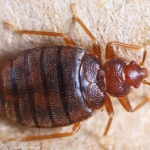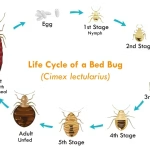Bed bug bites have a unique pattern that sets them apart – they appear in straight lines or zigzag rows of 3 to 5 bites, often described as a “breakfast, lunch, and dinner” arrangement. The bites themselves are red, raised welts about the size of an apple seed, and they’re intensely itchy. They most commonly show up on exposed skin areas during sleep: your arms, neck, shoulders, and legs. Unlike random mosquito bites, bedbug bites cluster together and often appear after waking up. You’ll rarely catch bedbugs in action since they feed at night, but their bite pattern is their telltale signature. I’ll guide you through each distinctive sign of bedbug bites and share exactly what to check on your skin to confirm your suspicions. In this article, I will also share some photos with you to help you understand whether your bites are bedbugs or other less worrisome insects (mosquitoes, fleas, spiders…). Once you’re sure they’re bed bugs, you can move on to inspecting your mattress, luggage and sofa, where they love to hide.
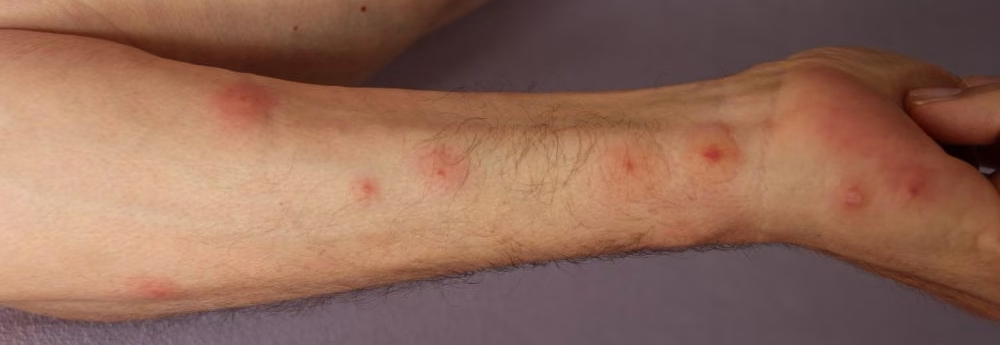
What do bedbug bites look like?
We can spot bedbug bites through several reliable signs. The most obvious sign of bedbug bites is their distinctive appearance – they form a clear linear or zigzag pattern on your skin. I’ve examined thousands of cases, and this pattern appears in about 90% of confirmed infestations. Fresh bites are raised, reddish-brown welts that typically measure 1-5 millimeters across. Unlike random insect bites, bedbug bites cluster in groups of 3-5, appearing on areas of skin exposed while you sleep. The bites often develop within hours but can take up to 14 days to appear in some people, depending on their skin’s reaction.
These blood-feeding insects tend to target the upper body, particularly around the neck, shoulders, and arms. What makes bedbug bites unique is their timing – you’ll notice new bites appearing after sleeping, and they often itch more intensely in the morning. Another telling sign is that multiple people sleeping in the same space may develop similar bite patterns. I always tell my patients to check their sheets for tiny brown or reddish spots – these are classic signs of bedbug activity that help confirm the source of bites.
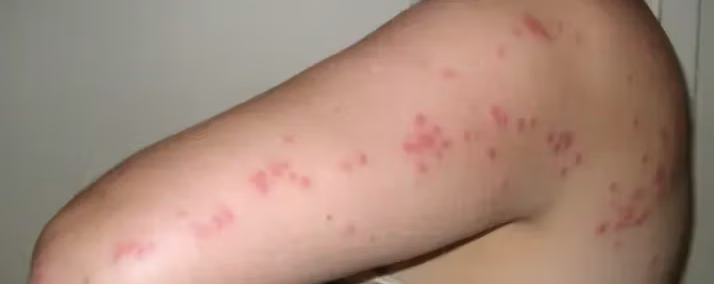
Difference between bedbug bites and other insect bites
Let’s learn how to tell bedbug bites apart from other common insect bites. While mosquito bites appear randomly across your body as separate, puffy bumps that itch immediately, bedbug bites follow that distinctive linear pattern we talked about. Mosquito bites also tend to start itching right away and usually fade within a few days. I’ve seen many patients confused between these two, but the pattern is your best clue.
Flea bites tell a different story. They typically cluster around your ankles and lower legs since fleas jump from the ground up. These bites are smaller than bedbug bites and often appear as tiny red dots surrounded by a light halo. Another key difference is that flea bites typically develop into small, hard welts almost immediately after being bitten, while bedbug bites might not show up for several hours or even days.
Here’s a quick comparison to help you identify your bites: Bedbug bites: Appear in lines or zigzag patterns, mainly on upper body and exposed skin during sleep, can take hours or days to develop, size of an apple seed Mosquito bites: Random placement, appear immediately, single large puffy bumps, fade within days Flea bites: Cluster around ankles and legs, tiny red dots with halos, appear immediately, intense itching right away.
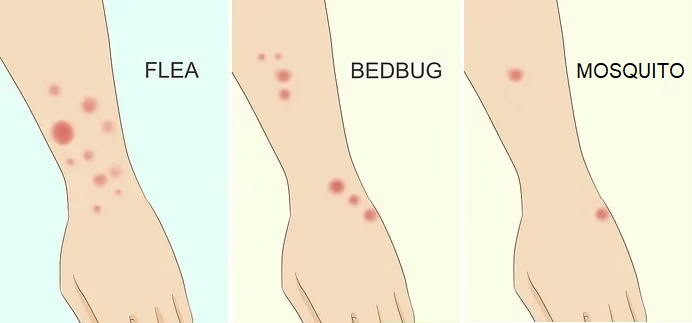
What are the symptoms of bedbug bites?
Understanding the symptoms of bedbug bites helps you identify them quickly and seek proper treatment. The most common symptoms start with an intense itching sensation that often becomes more noticeable in the morning. From my field research, I’ve observed that this itchiness typically develops within a few hours after being bitten, though some people might not react for several days.
The physical signs are quite distinctive. The bites usually appear as raised, red welts with a darker red center. Many of my patients describe a burning feeling around the bite area, and the surrounding skin often becomes swollen. These welts can range from small bumps to larger hives, depending on your body’s reaction. What makes these symptoms unique is how they cluster together – remember that breakfast, lunch, and dinner pattern we discussed earlier.
Watch out for signs that your bites are developing into a more serious skin condition. If you notice any of these symptoms getting worse, particularly if the redness spreads or you develop blisters, it could indicate a skin infection. I recently treated a case where what started as typical bedbug bites turned into a more severe reaction with widespread hives – this is when you should definitely seek medical attention. While most bedbug bites heal on their own within 1-2 weeks, monitoring your symptoms helps ensure proper healing.
What causes allergic reactions to bedbug bites?
Let’s understand why some of us react more severely to bedbug bites than others. When bedbugs feed, they inject their saliva into our skin, which contains unique proteins. Our immune system recognizes these proteins as foreign invaders, triggering an allergic reaction. I’ve observed that about 70% of people develop some kind of reaction, ranging from mild to severe.
In most cases, you’ll experience common symptoms like itching and redness. However, some people develop more intense allergic reactions that require medical attention. The signs of a serious reaction include severe swelling, blisters filled with fluid, widespread inflammation, or hives that spread beyond the bite area. If you’re having trouble breathing or feel your throat tightening, that’s a sign of anaphylaxis – a rare but dangerous condition that needs immediate emergency care.
During my years studying these reactions, I’ve noticed that certain groups tend to experience more severe symptoms. Children, elderly people, and those with compromised immune systems often show stronger reactions to bedbug bites. If you’re in one of these groups or develop any severe symptoms, don’t wait – contact your healthcare provider right away. While serious reactions are uncommon, it’s better to be cautious when it comes to your health.
How to treat bedbug bites?
Let’s tackle how to relieve those irritating bedbug bites with proven treatments. Your first step should be to wash the affected areas with soap and water to keep them clean. As an entomologist who’s helped hundreds of bite victims, I’ve found that simple hygiene is crucial for preventing infection and starting the healing process.
To reduce itchiness, you have several effective options. Start with over-the-counter treatments – apply an anti-itch cream containing hydrocortisone directly to the bites, it will relieve itchiness in few minutes. Many people find quick relief with these readily available solutions. For extra comfort, try placing a cold compress on the bites to reduce swelling and temporarily numb the skin.
If over-the-counter treatments aren’t providing enough relief, don’t suffer needlessly. More severe reactions might require prescription medication, particularly corticosteroid creams for intense itching and swelling. I recently worked with a patient whose bites weren’t responding to regular anti-itch creams – their doctor prescribed a stronger corticosteroid cream that finally brought relief. Remember to apply any medication exactly as directed, whether it’s over-the-counter or prescription strength, and avoid scratching to prevent infection.
Final thoughts on identifying bedbug bites
Remember, successfully identifying bedbug bites comes down to recognizing their key characteristics. The telltale bite marks we’ve discussed – those small red raised bumps appearing in a zigzag pattern – are your best clue. You might notice these reddish brown marks appear differently depending on your skin tone, becoming lighter or darker over several days.
While individual reactions vary, most bites start as flat or slightly raised bumps that can look similar to pimple-like bumps. What sets them apart is their predictable grouping and timing. I always tell my patients that if they notice these distinctive red dots appearing after sleep, especially in linear patterns, they should take immediate action to check their bedding and surrounding areas for signs of bedbugs.
Don’t let the presence of these persistent pests keep you up at night. Now that you can confidently identify bedbug bites, you’re better equipped to deal with them quickly and effectively. Remember, while the bites themselves are troublesome, they’re also your early warning system that lets you tackle a potential infestation before it becomes severe. Take action at the first sign of these characteristic bites, take a look at our article on effective products against bed bugs.
Scientific References
1. Centers for Disease Control and Prevention (CDC)
“About bed bugs”
Division of Parasitic Diseases
A comprehensive review of bedbug biology, behavior, and public health implications.
2. National Health Service (NHS UK)
“Bedbugs – Symptoms and Treatment”
Health A-Z
Last reviewed: December 2023
Evidence-based medical information about bedbug bites and infestation management.
